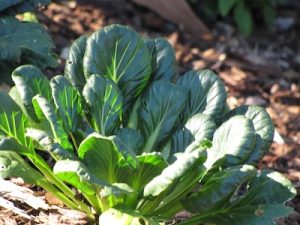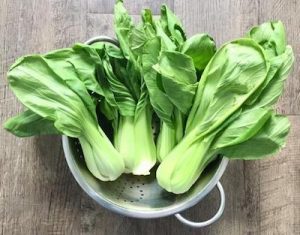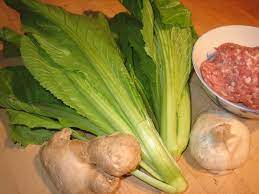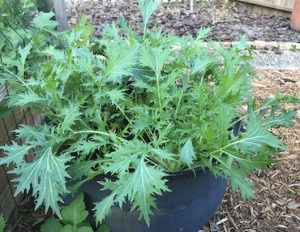Extend Your Growing Season with Asian Greens
By Janet Scheren, Fairfax Master Gardener

Tatsoi
If you’re getting adventurous with your vegetable garden and looking for crops to harvest from the dead of winter into spring, it is time to investigate Asian greens. These greens can help to fill the “hungry gap” when those used to eating the best and freshest from the garden have to turn to commercial produce to fill the fridge. Asian greens are not only flavorful and versatile in dishes from salads to cooked greens, as members of the Brassica family, they are also highly nutritious. Some even lend an ornamental flair to your garden.
Asian greens come in a wide array of leaf shapes, textures and flavors. Tatsoi and bok choy/pak choi boast smooth and creamy leaves. For more crunch, try Chinese cabbage or the serrated leaves of mizuna. You can also add some kick to your salads with one or more of the many varieties of Asian mustards.
Here are some Asian greens that are particularly well suited to our Zone 7 Northern Virginia gardens.
- Tatsoi
Tatsoi (pronounced taht-SOY) is similar in flavor to bok choy. This gourmet green is a rich source of vitamin C along with calcium, carotenoids to promote eye health and cancer fighting compounds — to name a few. Its low-growing rosettes are formed from glossy dark green, spoon-shaped leaves that are crisp and juicy. It is wonderful in stir fries and salads. Like many Brassicas, a light frost can improve its flavor. Harvest individual leaves or the whole plant. It is cold hardy to 10° F and ready to harvest only 43 days after germination. - Mizuna
Mizuna is a hardy plant that is both heat and cold tolerant. It has a peppery flavor and high nutritional content — vitamins A, C and K; and folate and iron. It germinates in soil as cold as 40° F and is hardy to about 15° F. For colder winters, it can survive in a cold frame or hoop house. It works well in a salad mix, stir fries, fried rice and soups at full-leaf size. - Tokyo Bekana
This frilly and fast growing chartreuse green is very tender and delicious in salads. It has a mild flavor and can be harvested within 21 days as a baby green. - Wong Bok/Bok Choy/Pak Choi

Bok Choy
Most consumers have encountered these in the supermarket or enjoyed them in stir fries. They are extremely cold hardy, and like their cousins, are extremely nutrient dense. In fact, boy choy is ranked at the top of the nutrition list — even higher than spinach and broccoli. A purple variety adds extra phytonutrients and is perfect for the wok, grill or in salads.
- Asian Mustard Greens
You can also add some kick to your salads with one or more of the many varieties of spicy mustards. Some are quite spicy while others are fairly mild. Choose from frilly, spoon-shaped, red-veined, red-leaved and golden leaf varieties. Some, such as New Star Mustard, are bred to withstand temperatures as low as 6° F.
The last weeks of summer — late August into September — is the best time to sow cool season Asian greens. You can sow them directly into prepared soil or start them in seed trays indoors. Transplants can fill holes in your garden as summer crops are removed. They also grow well in containers — either as individual plants or sown as a mixture of several varieties.
Additionally when sown in the fall, they grow from warmer to cooler temperatures and longer day lengths into shorter day lengths. This delays their tendency to bolt, or flower. It also puts them in your garden at a time when there are fewer pests, such as flea beetles, to damage their leaves.

Mustard Greens
Asian greens are grown in much the same way as kale and collards. If grown in hot weather, be sure to provide enough water to prevent the leaves from becoming bitter. You’ll also need to weed between plants to keep them free of competition.
If grown in the spring, row covers or insect mesh can provide a barrier to prevent flea beetle damage. Clear leaf litter in early winter to reduce the potential for overwintering these pests. Slugs are another nuisance to look out for. If you notice holes in the leaves, check your plants at dusk and pick off any slugs you see or set up slug traps.
While these are some of the hardiest greens you can grow, surviving in frosty weather is not the same as growing in cold weather. Setting up a hoop house or cloche will improve growth rates in cold winter weather.
Most Asian greens can be harvested whole by cutting through the base of the plant. For more open plants, such as mizuna, they can be harvested leaf by leaf, working from the outside or bottom of each plant.

Mizuna
When harvesting in very cold weather, the leaves may be still frozen during the morning hours. Wait until the warmth of the sun thaws the leaves before picking them. They won’t recover if harvested while still frozen.
If your plants make it through the winter into spring, they will eventually flower. Tatsoi, for example, makes an attractive ornamental in the garden with small yellow blossoms that bees and other pollinators love to visit. Unless you remove the blooms before going to seed, they may self-seed for the following season. This can be a nice bonus or a nuisance, particularly if pollination has created an undesirable hybrid with related plants nearby.
While I haven’t seen Asian green seedlings for sale, it’s easy to find seeds. Check with your local garden center or any of the dozens of reputable seed companies online. Most will have a nice selection. Always check to be sure the Asian green you select is suited to Zone 7 hardiness. Fairfax County is Zone 7a.
Resources
Grow Great Virginia Vegetables, Ira Wallace
Spice Up Your Garden and Your Diet With Asian Greens, Der Holcomb, NC Cooperative Extension
Tatsoi, University of Arizona, College of Agriculture and Life Sciences